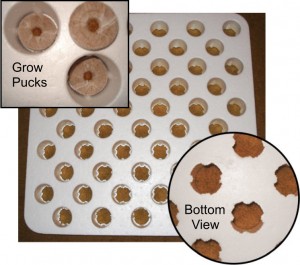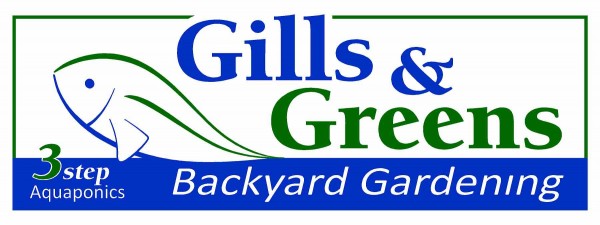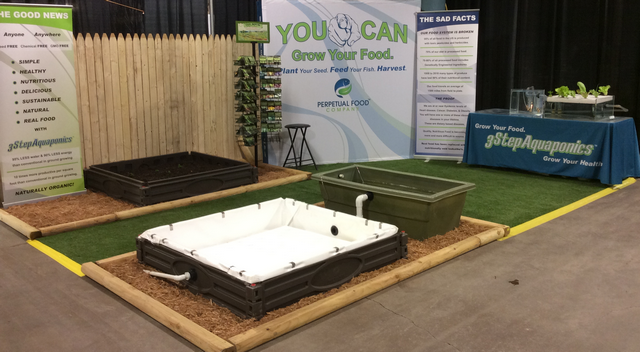 So how does an aquaponics system work?
So how does an aquaponics system work?
An aquaponics system operates under the same principles as a lake, a river, or other ecological system. All aquaponics systems, however, keep the plants and fish separate because the fish eat the roots of plants. They are herbivores. So, by necessity, the aquaponics system is composed of two compartments; one tank for the plants and one tank for the fish.
 In the plant tank, commonly called a grow bed, we use Expanded Polystyrene floats as a growing platform. Other people choose to use a solid media bed for growing. We feel that the float system is the cleanest and requires the least amount of work. Each float has holes cast into the material that define the number of plants (32 for 2’x4’ and 55 for 2’x2’) that each float can handle. One can choose between either one 2’x4’ or two 2’x2’ floats for each 2’ wide section in the grow bed. That choice will be determined by the selection of plants you want to grow or whether you want to use part of your grow bed for growing seedlings. At the bottom of each cast hole there are four little feet cast into the floats that help support a “puck” of coir growing media. The puck is dry and compressed with a surrounding cotton mesh. One is inserted in each location before the float board is placed on the water in the grow bed, and a seed is then placed in the center depression of each puck. When the puck gets wet it begins to expand and develop into a plug of wet porous media with a hole in the center that forms a depression where the seed can germinate and grow its roots down to the nourishing water.
In the plant tank, commonly called a grow bed, we use Expanded Polystyrene floats as a growing platform. Other people choose to use a solid media bed for growing. We feel that the float system is the cleanest and requires the least amount of work. Each float has holes cast into the material that define the number of plants (32 for 2’x4’ and 55 for 2’x2’) that each float can handle. One can choose between either one 2’x4’ or two 2’x2’ floats for each 2’ wide section in the grow bed. That choice will be determined by the selection of plants you want to grow or whether you want to use part of your grow bed for growing seedlings. At the bottom of each cast hole there are four little feet cast into the floats that help support a “puck” of coir growing media. The puck is dry and compressed with a surrounding cotton mesh. One is inserted in each location before the float board is placed on the water in the grow bed, and a seed is then placed in the center depression of each puck. When the puck gets wet it begins to expand and develop into a plug of wet porous media with a hole in the center that forms a depression where the seed can germinate and grow its roots down to the nourishing water.
 The fish tank is aerated to keep oxygen in the water to allow the fish to breath. It must be big enough to hold the number of fish you determine as necessary to handle the number of plants that you want to grow. We believe in using a minimum number of fish so that the solids excreted by the fish can be handled by the bacteria in the system as discussed below. If one chooses to have a lot of fish, then solids become a problem that must be dealt with by adding a filter and settling tank.
The fish tank is aerated to keep oxygen in the water to allow the fish to breath. It must be big enough to hold the number of fish you determine as necessary to handle the number of plants that you want to grow. We believe in using a minimum number of fish so that the solids excreted by the fish can be handled by the bacteria in the system as discussed below. If one chooses to have a lot of fish, then solids become a problem that must be dealt with by adding a filter and settling tank.
The unseen part of the aquaponic system is the colony of bacteria that converts fish solid and liquid waste into fertilizer for the plants. The bacteria need oxygen just like the fish, and since the bacteria live everywhere in the system, both tanks in the system must be constantly oxygenated by air from an aeration pump. The fish make their donation to the system by excreting into the water both ammonia and urea, a chemical converted by bacteria into ammonia. Ammonia then must be converted to Nitrate by another family of bacteria. Both ammonia and a chemical intermediate, nitrite, are toxic to fish and must be kept to a minimum by bacterial conversion. Nitrate is the fertilizer or chemical form plants need to get nitrogen that allows them to grow their structures. Without the bacteria the plants would not grow and the fish would die from their own toxic chemicals. The convenient part is that the bacteria come from the air and grow in the system once the fish start excreting ammonia.
The last operational aspect of the system is how water is moved from one tank to the other. First, the tanks are connected together by pipe. Since the fish tank is higher than the grow bed, water flows by gravity from the fish tank into the grow bed. There is a coarse filter between the tanks to prevent fish from entering the grow bed and eating the plant roots. The water flows along the grow bed and is picked up by a small centrifugal pump that returns it to the fish tank. Another coarse filter is located at the outlet of the grow bed to protect the pump from any loose roots lost by the plants.
We have taken what is ultimately a fairly complex, natural eco-system and developed a backyard garden system that’s as easy as 1, 2, 3! You Plant the seed, Feed the fish, Harvest the food! No Weeding!! No Tilling!!

